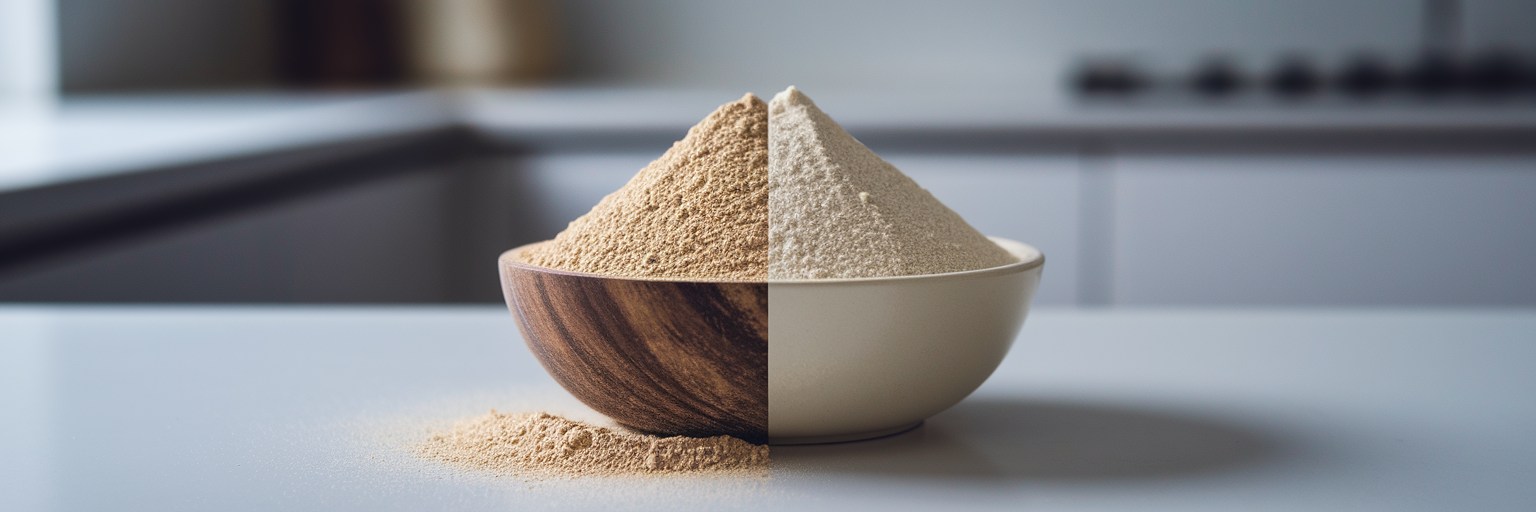Why Texture Is Everything for Your Protein Shake
You’ve committed to a plant-based lifestyle, which is fantastic. But let's be honest, the daily ritual of choking down a gritty protein shake can feel more like a chore than a treat. If you've ever swirled the last sip of your drink only to find a layer of sandy sediment at the bottom, you are not alone. We get it, and there’s a reason why that texture can ruin the whole experience.
Our brains are wired to associate certain textures with satisfaction. Think about the difference between a velvety, rich soup and a thin, watery one. The creamy version feels more nourishing and enjoyable. The same principle applies to your protein shake. A smooth, consistent blend signals quality and palatability, making it something you actually look forward to. When the plant protein powder texture is off, it creates an unpleasant sensory experience that can make it difficult to stick with your supplement routine, no matter how great the nutritional benefits are.
This chalky feeling is a common hurdle with plant-based proteins. The reason is simple: plants are naturally fibrous. While that fiber is great for your gut, it can make creating a perfectly smooth vegan protein powder a real challenge. That fibrous structure is what we need to overcome to get that creamy shake you deserve, and understanding why it happens is the first step to finding a better powder.
The Science Behind Gritty Plant Protein

So, what exactly causes that disappointing, sandy texture in some plant proteins? It mostly comes down to two things: particle size and solubility. Imagine mixing sand into a glass of water. The grains don't dissolve; they just swirl around and eventually settle at the bottom, creating a gritty mouthful. Now, picture mixing sugar into water. It dissolves completely, creating a smooth liquid. Many lower-quality plant protein powders behave more like sand than sugar because their particles are too large and not very soluble.
Another factor is insoluble fiber. This is the tough, structural part of plants that doesn't dissolve in water. While beneficial for digestion, high amounts of it in a protein powder contribute directly to a rough, fibrous mouthfeel. This is often the culprit behind the notorious pea protein gritty texture that many people complain about. Brown rice protein is another source that is naturally dense with insoluble particles, making it difficult to smooth out on its own.
This is why protein blends are often superior. Formulators can balance the creamy, more soluble properties of one protein with the nutritional profile of another. Understanding these natural differences is key to picking a product you'll enjoy. For those looking to compare their options, our guide to the best protein powders offers a more detailed look.
| Protein Source | Typical Natural Texture | Key Challenge | Best For |
|---|---|---|---|
| Pea Protein | Relatively creamy, can have a chalky finish | Solubility can vary | Great base for blends |
| Brown Rice Protein | Often described as sandy or gritty | High level of insoluble particles | Blends where it's not the primary source |
| Hemp Protein | Earthy and fibrous | High fiber content | Smoothies where other ingredients mask texture |
| Soy Protein | Generally smooth and soluble | Can have a distinct flavor | Standalone powders or smooth blends |
Note: This table reflects the typical characteristics of these proteins in their basic form. Advanced processing, as discussed later, can significantly improve the texture of any source.
Ingredients That Create a Creamier Blend
While the base protein is important, the secret to a truly smooth shake often lies in the supporting ingredients. Smart formulators add specific "smooth-makers" to their blends to perfect the texture and mixability. When you're scanning an ingredient list, here are the helpers to look for:
- Gums and Thickeners: Ingredients like guar gum and xanthan gum are your best friends for a creamy shake. Think of them as helpers that give the liquid body and viscosity, preventing the protein particles from settling at the bottom. This ensures your last sip is just as smooth as your first. As supported by research in journals like Food Hydrocolloids, these ingredients, known as hydrocolloids, are essential for creating a pleasant mouthfeel in plant-based foods.
- Emulsifiers: Have you ever tried mixing oil and water? They separate almost immediately. An emulsifier, like sunflower lecithin, acts as a matchmaker between the powder and the water. It helps them blend together seamlessly and stay mixed, preventing those stubborn clumps from forming.
- Smart Protein Blends: The best tasting plant based protein powders rarely rely on a single source. By combining a creamier protein, like pea, with a nutrient-dense but grittier one, like rice, formulators create a synergistic blend. The final product has a complete amino acid profile and a texture that is far smoother than either ingredient could achieve alone.
- Healthy Fats: A little bit of fat goes a long way in creating a rich, satisfying mouthfeel. Ingredients like powdered coconut milk or ground flaxseed can add a luxurious creaminess, much like adding a splash of cream to your morning coffee.
Once you have a powder with a smooth base, you can create delicious and satisfying shakes and snacks. For some great ideas, check out these easy vegan protein recipes you'll actually crave.
How Modern Processing Unlocks Smoothness

Beyond a smart ingredient list, the real secret weapon for premium protein powders is advanced manufacturing. This is where technology steps in to solve the texture problem at its source and provides the answer to how to fix chalky protein powder before it even gets to your shaker bottle.
One of the most important techniques is micronization. You can picture this as milling the protein particles into a powder so incredibly fine it behaves more like flour or dust than sand. These tiny particles have a much larger surface area, allowing them to dissolve almost instantly in liquid and eliminating that gritty feeling. The effectiveness of this process is confirmed by research in publications like the Journal of Food Engineering, which notes that finer particle sizes dramatically improve solubility and mouthfeel.
Another key process is spray drying. Instead of just grinding up dried plants, manufacturers turn the liquid protein extract into a fine mist and pass it through a current of warm air. This instantly evaporates the water, leaving behind a uniform, highly soluble powder. This method helps prevent the clumping and poor mixability often found in more coarsely processed products.
Finally, some of the most sophisticated powders use enzymatic treatment. This is a smarter, more natural step where specific enzymes are used to break down or "pre-digest" the most fibrous and gritty parts of the plant protein. This is done before the powder is even dried, resulting in a product that is inherently smoother without the need for harsh chemicals or excessive additives.
Your Checklist for Buying a Better Protein Powder
Now that you know what separates a gritty shake from a great one, you can shop with confidence. Finding a truly smooth vegan protein powder is much easier when you know what to look for. Here is a simple checklist to guide you:
- Scan the Label for Keywords: Look for terms on the packaging like "micronized," "ultra-fine," or "instantized." These are clear signals that the powder has undergone advanced processing for better mixability and a smoother texture.
- Favor Blends and Helpers: Unless you know you love a specific single-source protein, choose a blend (like pea and pumpkin seed). Also, check the ingredient list for beneficial additions like guar gum, xanthan gum, or sunflower lecithin. These are signs of a well-formulated product.
- Try Before You Buy: Texture is a personal preference. If possible, start with a sample pack or the smallest available size of a new powder. This is a low-risk way to find a product you genuinely enjoy drinking every day.
For instance, our Chocolate Vegan Protein is specifically formulated using finely milled pea protein and a blend of ingredients to deliver that smooth, creamy texture you're looking for. Now that you're an expert on texture, feel free to explore our full collection of supplements designed for quality, taste, and performance.



